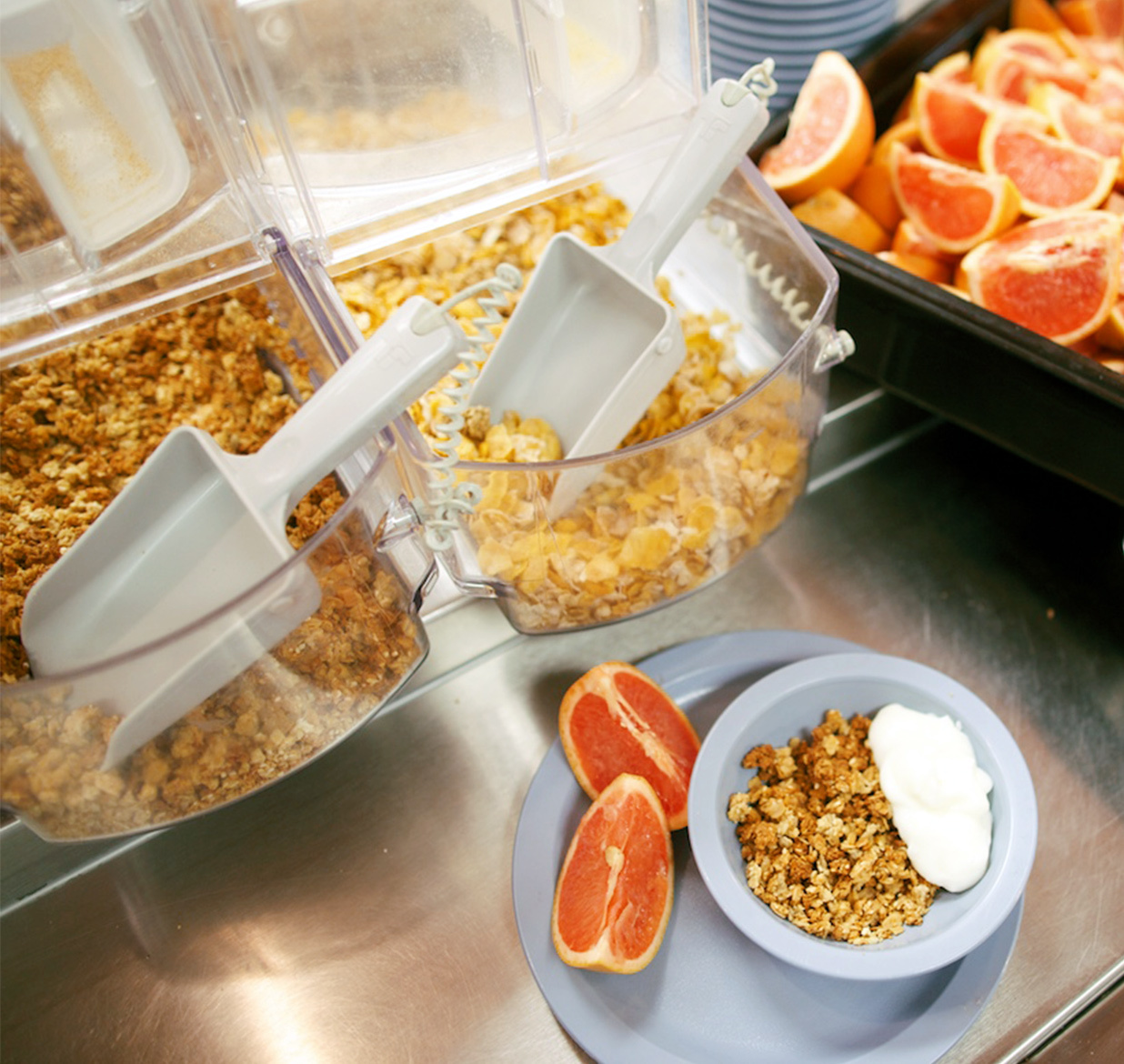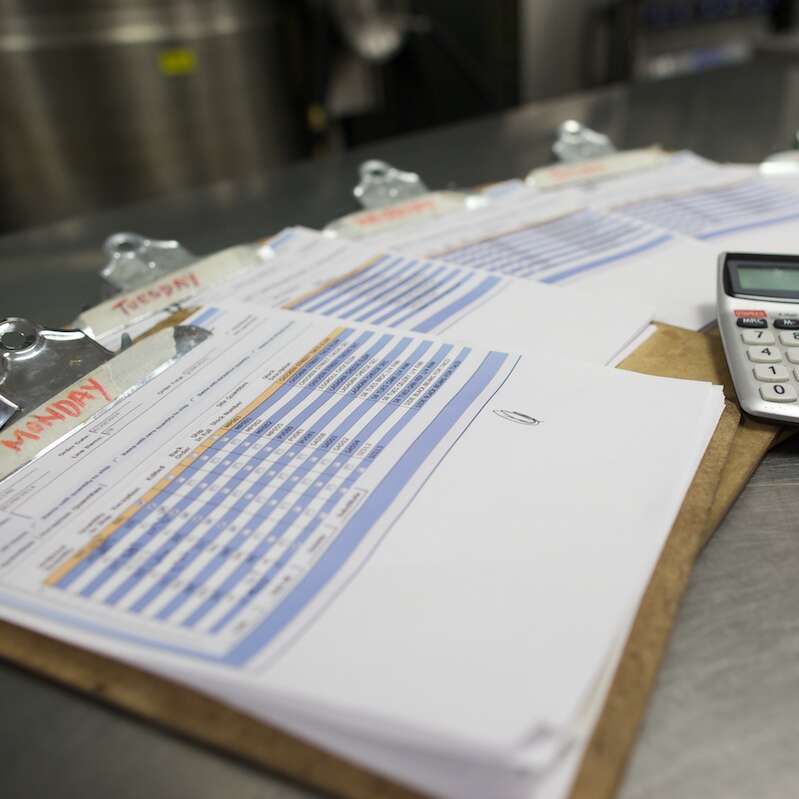
School Breakfast: Getting Started
Expanding the locations and methods used to serve breakfast in your district impacts many areas of your operation—from fiscal tracking to assigned labor hours and the foods served. Breakfast also impacts the daily routine and schedules of the school sites. Principals, custodians, teachers, and parents are all impacted by adding or changing breakfast service at their school. Preparation for change includes studying other “best practices” as well as identifying what type of expansion is most feasible through fiscal analysis.

School Breakfast: Getting Started
Expanding the locations and methods used to serve breakfast in your district impacts many areas of your operation—from fiscal tracking to assigned labor hours and the foods served. Breakfast also impacts the daily routine and schedules of the school sites. Principals, custodians, teachers, and parents are all impacted by adding or changing breakfast service at their school. Preparation for change includes studying other “best practices” as well as identifying what type of expansion is most feasible through fiscal analysis.
Considering Expansion
If your district is considering expansion of school breakfast, there are many useful toolkits and resources available to support your efforts. Here are some of our favorites:
- School Breakfast Program Toolkit (USDA)
- School Breakfast Expansion Strategies (Food Research & Action Center)
- School Breakfast Program (John C. Stalker Institute)
Additionally, local, state, and federal agencies are working throughout the country to provide the support, information, and education necessary for districts to successfully start or expand their breakfast programming.
Rather than duplicate work that is done well by others, we focus on the food service department’s operational and fiscal requirements to identify the best possible service model. We will also explore the essential factors for sustainable and successful breakfast programs.
Feasibility
Determining Feasibility and Expansion Type
What are your best opportunities for expansion? If your state legislation requires implementation of breakfast after the bell, and you are not currently compliant, then the state guidelines will outline the direction that you need to take. If there is no state legislation in place, how do you determine the expansion options that will work for you?
It’s not uncommon to see a blend of service options from Traditional Breakfast to Breakfast in the Classroom (BIC) in a single district. A flexible breakfast program can enable you to maximize participation levels depending on each school’s characteristics.


Feasibility
Determining Feasibility and Expansion Type
What are your best opportunities for expansion? If your state legislation requires implementation of breakfast after the bell, and you are not currently compliant, then the state guidelines will outline the direction that you need to take. If there is no state legislation in place, how do you determine the expansion options that will work for you?
It’s not uncommon to see a blend of service options from Traditional Breakfast to Breakfast in the Classroom (BIC) in a single district. A flexible breakfast program can enable you to maximize participation levels depending on each school’s characteristics.
While breakfast service decisions are often determined on a school-by-school basis with consideration for individual site criteria and needs, it’s important to remember that the overall success of breakfast implementation is defined by your ability to balance the expenses and revenues in your fund. A common question is: what is the threshold of eligibility that will ensure fiscal success for universal breakfast implementation? And more specifically, what is the eligibility threshold for free and reduced-priced meals that will ensure fiscal sustainability for a universal BIC model? The common presumption is that a school should have at least 60% eligibility for free and reduced-priced meals to justify operating a universal program, but many districts challenge that notion.
Districts with 40% to 100% eligibility for free and reduced-priced meals can operate universal BIC in schools. They evaluate the potential by analyzing the probable participation results across their sites. As long as expenses do not exceed revenue, their breakfast expansion is fiscally sustainable. For traditional cafeteria breakfast service served before the bell, a typical threshold for implementation is 35% eligibility for free and reduced-price meals. Still, it is not uncommon to see breakfast offered at much lower thresholds.
Traditional breakfast can be managed with limited labor (depending on the menu), providing an option for hungry kids regardless of income level. Our Breakfast Site Calculator and Breakfast District-Wide Calculator will assist in analyzing the feasibility of expansion for your district. You can build “what if?” scenarios by setting up presumptions of participation based on the planned breakfast models at each school in your district. The calculator will then extrapolate the revenue and expense for you.
Fiscal Health
Assessing your department’s fiscal health and preparing a fiscal management plan are essential first steps when expanding a breakfast program. Due to the additional costs that come with running an effective breakfast program, taking time to adjust your budget will allow for a smooth transition and a sustainable program. By taking advantage of our Fiscal Management resources, you will have all of the pertinent data on labor, student participation, and the fiscal health of your department’s fund in one place. The critical data sets are:
- By-site enrollment and eligibility data
- Average daily participation by meal type
- Average daily participation by eligibility
- Staffing information by school site: number of employees, total labor hours
- Current fund health: fund balance available to cover early start-up costs or deficits as the new breakfast program develops
- Operational model type
- District student transportation program
Preparing for Launch
After assessing the feasibility of expanding a breakfast program both operationally and fiscally, it is also essential to consider the program’s feasibility. Consider whether you have the full support of key stakeholders, if your food service team has the capacity, which breakfast model would be best for each school site, and the type of training needed for all school site employees. All of these factors will dictate what the expansion of your breakfast program will look like and the steps needed to lead to a successful launch and sustainable program. Depending on your team’s capacity and timing, you’ll have to decide what rollout schedule makes sense for your district. Your primary goal should be a smooth and successful rollout since nothing can derail breakfast programs faster than a poor launch. Consider the following planning out the launch of a program:
School Wide Plan
Involve the whole school site team, including food service staff, principals, teachers, paraprofessionals, and custodians. The food service team orchestrates the program but will need the support and cooperation of the school team. Everyone needs to be informed and trained. See a sample Breakfast Plan for the School Team.
Unlike Traditional Breakfast, BIC and Grab ‘n Go are successful when all key stakeholders know their role and are motivated and organized. Regardless of how prepared everyone may be, the rollout of any new program can test the nerves of many.
Accountability
There are several methods for accountability. Our Breakfast Accountability Procedures can be customized to fit any implementation model. For BIC accountability, you will typically need to train the teacher or paraprofessional on meal identification and recording of which students have taken a meal.
Roster check-off is the most common method in which weekly rosters are delivered daily with the food, filled out by the classroom staff, picked up with the leftovers, and entered into the Point-of-Sale System (POS) by food service staff. For Grab ‘n Go, some districts have mobile device options for their POS, or many schools simply use their computers and PIN pads wirelessly (or offline and perform an upload later). If the school is Provision 2 or operating under the Community Eligibility Provision (CEP), student numbers are not required. In that case, regardless of the model, a simple student count can be utilized, but some districts retain the use of rosters if the school falls out of eligibility for Provision 2 or CEP.
Trash Collection and Classroom Cleanup
Breakfast eaten in the classroom usually requires custodial cooperation since additional trash is generated outside the cafeteria’s contained venue. By involving the custodial staff in the early planning, you can establish their commitment to the disposal and cleanup process.

One common solution for classroom delivery is a trash bag delivered along with the meals to each classroom, and then the students collect their own trash and place it either outside the classroom or in trash bins in the hall. The custodian would then collect the waste and dispose of it. In Grab ‘n Go models, a bag is often already used when the student picks up their breakfast, so those bags can be used for their trash and placed in a hallway trash bin.
If your school is set up to recycle food packaging, here is a Breakfast Recycle Bin Sign. Districts that compost food waste often provide a compostable bag and compost bins placed in the classroom or hallway. Typically, waste collection does not need additional time from the custodian.
School districts also use a variety of ways to manage mess in the classroom, such as deli paper for placemats, bulk-packing breakfast meal components to reduce packaging waste, and gentle all-purpose cleaner (more kid-friendly than bleach solutions) and paper towels to each classroom so the students can assist in cleaning desks. The primary task is to establish a routine with the cooperation of the school team, and then reinforce the training with the students.

One common solution for classroom delivery is a trash bag delivered along with the meals to each classroom, and then the students collect their own trash and place it either outside the classroom or in trash bins in the hall. The custodian would then collect the waste and dispose of it. In Grab ‘n Go models, a bag is often already used when the student picks up their breakfast, so those bags can be used for their trash and placed in a hallway trash bin.
If your school is set up to recycle food packaging, here is a Breakfast Recycle Bin Sign. Districts that compost food waste often provide a compostable bag and compost bins placed in the classroom or hallway. Typically, waste collection does not need additional time from the custodian.
School districts also use a variety of ways to manage mess in the classroom, such as deli paper for placemats, bulk-packing breakfast meal components to reduce packaging waste, and gentle all-purpose cleaner (more kid-friendly than bleach solutions) and paper towels to each classroom so the students can assist in cleaning desks. The primary task is to establish a routine with the cooperation of the school team, and then reinforce the training with the students.
Recommended Topic: School Breakfast Operations
In every district, the variety of school building types, age, and access means that there may be as many customizations to breakfast operations as there are schools. The overarching goal is to create efficiency by implementing standard operating procedures and menu cycles, as well as adequate staff training in breakfast procedures and the importance of breakfast.
Recommended Topic: School Breakfast Operations
In every district, the variety of school building types, age, and access means that there may be as many customizations to breakfast operations as there are schools. The overarching goal is to create efficiency by implementing standard operating procedures and menu cycles, as well as adequate staff training in breakfast procedures and the importance of breakfast.



